Ireland’s forgotten ‘Great War’?
Published in Features, Issue 4 (July/August 2019), Volume 27Re-evaluating the American Civil War’s place in Irish history.
By Damian Shiels
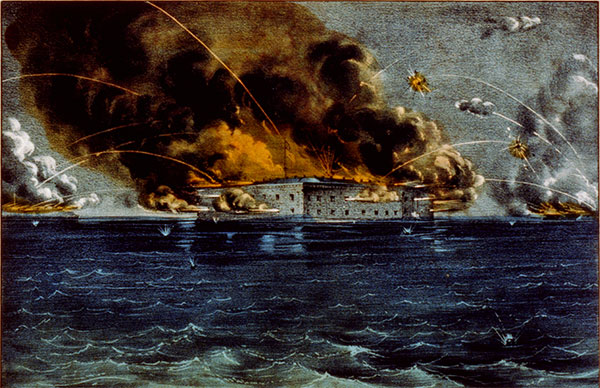
Above: The bombardment of Fort Sumter in April 1861, the action that opened the war. More soldiers in the garrison had been born in Ireland than in the United States, and two of them would be the first Union dead of the Civil War. (Library of Congress)
On 28 June 1950, County Limerick native Jeremiah O’Brien died in Kirbyville, Texas, claiming the great age of 105 years. The vast majority of his life had passed in unremarkable fashion, lived in relative obscurity and poverty. What made his death worthy of comment in Harry Truman’s America were the actions of his youth, coupled with his extreme longevity, for Jeremiah O’Brien was one of only a handful of men left in the state of Texas who claimed to have served the Confederacy during the Civil War. With his passing, the last known Irish-born link to the conflict was severed.
While the era of the American Civil War can appear lost in the mists of time, the grandsons of men who fought with Sheridan in the Shenandoah Valley, battled rebels in the woods of Chickamauga and ran the gauntlet of the Mississippi River forts are still alive in Ireland today. The immense scale of Irish involvement in the Civil War and its profound impact on Irish communities on both sides of the Atlantic make it a major part of the modern Irish story. Indeed, for many of Ireland’s counties, the American Civil War almost certainly saw more of their men fight—and more die—than any other conflict of the last two centuries.
More soldiers born in Ireland than in the United States
The ramifications for the Irish of the war between North and South became apparent from the moment of its opening shots. As Confederate guns let loose on Fort Sumter in Charleston Harbor on 12 April 1861, they did so against a garrison that contained more soldiers born in Ireland than in the United States. This was true of the regular army generally, a reflection of its role as a source of immigrant employment. When the explosion of a Sumter artillery piece flung the first six casualties of the fighting into the air, five of them were Irish. Two of them—Daniel Hough from County Tipperary and Edward Gallway from Skibbereen, Co. Cork—became the first to lose their lives in the conflict. The Irish were still dying four years and some three quarters of a million corpses later. In the early hours of 9 April 1865, Tom Smyth from Ballyhooly, Co. Cork, breathed his last in a lonely Virginia house, becoming the last Union general to die on campaign in the American Civil War. Later that day, Robert E. Lee surrendered to Ulysses S. Grant at Appomattox courthouse. All told, tens of thousands of Irish Americans perished between 1861 and 1865, inflicting immense loss on innumerable Irish families in America and Ireland. For many, it added still further to a catalogue of trauma that had begun with the Great Famine more than a decade earlier.
The Irish press had been quick to recognise the potentially devastating impact of the Civil War on Irish families. On 31 May 1861 the Cork Examiner expressed their fears that the fighting ‘threatened as much sorrow, widowhood and affliction to the home of Ireland, as of America itself’, going on to predict that ‘many a fireside from Dunluce to Castlehaven will be filled with mourning as each American mail arrives’. Doubting the potential for a speedy resolution, they correctly foretold that in the battles to come ‘the lives of her [Ireland’s] exiled children will be offered in thousands’.
One-sided participation
The Irish part in the struggle that engulfed America is dominated by its significance for the Fenian movement and by larger-than-life figures such as Thomas Francis Meagher and his Irish Brigade. Yet most Irish servicemen were not ardent Fenians, and the great majority did not serve in ethnic Irish regiments. Indeed, the consistency of focus on Meagher and his brigade, while undeniably important, has served to mask the true scale of Irish participation. That participation was not only colossal but was also overwhelmingly one-sided.
Sustained Irish emigration, most notably that triggered by the Great Famine, resulted in more than 1.6 million Irish-born people making the United States their home by 1860. Struggling against both poverty and prejudice, the majority inhabited ethnic enclaves in the country’s major urban centres. The largest cities were in the North, and some 1.5 million of the total lived in states and territories that would remain loyal to the Union when the firing started. A visitor to New York City or Boston on the eve of war would have found that one in every four people they encountered had been born in Ireland. Almost 100,000 Irish-born inhabited Philadelphia—a figure bested only by New York, where more than twice that number resided. The inevitable result of this concentration was that while 20,000 Irish natives marched to war wearing Confederate gray, some 180,000 did so clad in Union blue. During the conflict, many of the federal branches of service maintained a particularly Irish character; 20% of all the wartime enlistments into the Federal Navy and the expanding professional regulars were born in Ireland. But it was in the specially formed northern volunteer regiments that the great bulk of the Irish served—around 150,000 of them. At least 40,000 marched to war as representatives of Pennsylvania, Massachusetts and Illinois, with more than 50,000 departing from New York alone.
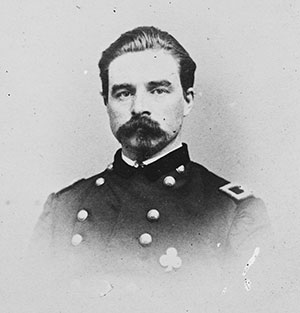
Above: Tom Smyth from Ballyhooly, Co. Cork, the last Union general to die on campaign during the American Civil War. (Library of Congress)
Even these 200,000 Irish-born represent only a partial picture. As an ethnic group, the Irish in the United States were extremely cohesive. The words and actions of those born to Irish parents in America, Britain and Canada indicate that they formed an intrinsic part of Irish American communities, and that their Irish ethnicity formed a major component of their identities. One of them was John Corcoran of the 2nd Massachusetts Infantry, who had been born in England to Irish parents. When rumours circulated in 1862 that Britain was on the verge of recognising the Confederacy, he raged that ‘if England was to intifere i wold neaver take a live English Soldiger i am down on that nation and willing to Do anything for to see that Naishion fall and iraland the Home of the Brave free from Her Enamees Hands …’.
Irish American identity was also a major factor for John Slattery, the American-born son of Limerick emigrants who had made their new home in Utica, New York. Having enlisted in a Massachusetts regiment while away for work, he later confided to his sister that he wished he had gone back to New York to join up, ‘for I should like to be in the same Regt with the Utica boys there is only two Irish fellows in this company besides myself …’. The available estimates indicate that the inclusion of the foreign-born Irish like John Corcoran and John Slattery brings the total ethnic Irish American contribution to Union arms into the region of a quarter of a million men.
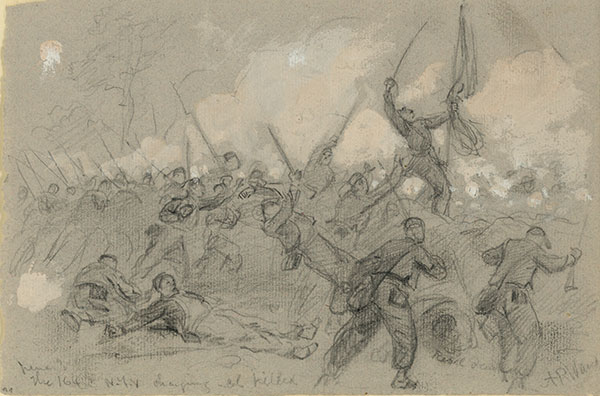
Above: Drawing of Colonel James P. McMahon (holding the flag) being shot down as he led troops of the 164th New York, part of the Irish Legion, against Confederate positions at Cold Harbor, Virginia, in June 1864. The Legion was the most Fenian formation in the Union Army. (Library of Congress)
Close ties with their home communities
Although they had departed Ireland’s shores, Irish Americans of the Civil War era often maintained extremely close ties with their home communities, ties that were of vital importance for those still in Ireland. Without such connections, the chain migration that characterised Irish emigration across decades would not have been possible. Between the height of the Famine and the conclusion of the American Civil War, more than $100 million was remitted across the Atlantic from Irish America. This helped not only to pay for passage but also to sustain those who had remained through the hard times. Private John Shea of the 1st Kansas Infantry was one of those who regularly funnelled money back to Ireland, supporting his mother and sister in Cahersiveen, Co. Kerry. In a letter accompanying one payment, he asked his mother to ‘keep my sister to school and if I can I will soon sind for her … Let me know whether you [will] let my sister come or not, as I donte want to be sinding for her if you donte let her come …’. Those who had emigrated tended to be viewed as the fortunate ones, and remittances were often seen as an obligation. By the time Mary Madigan from Causeway, Co. Kerry, wrote home to her sister in 1863 she had endured a harrowing few years. Mary had taken her young family to America following her husband’s death from dropsy in ‘Black ’47’. There she met and married another Irish immigrant, a ‘habitual drunkard’ who subjected her to ‘ill-treatment and brutality’. She eventually sought shelter with her eldest son, who shortly afterwards was mortally wounded in the first major battle of the war. Despite having sympathy for Mary’s hardships, her Irish-based sister still took time to admonish her for her failure to send more money home, stating that ‘ye have made as I thought faithfull primisses [promises] but slow performances’.
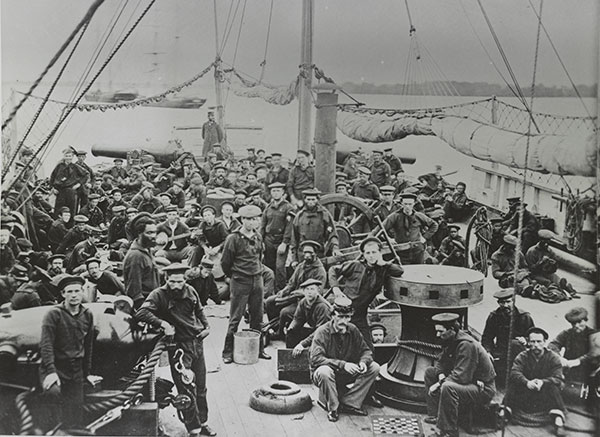
Above: Union sailors on the deck of a warship. Twenty per cent of the Federal Navy were Irish-born. (Library of Congress)
Such financial aid was not limited to family or community groups. This is typified by the 1863 response of Irish American soldiers and sailors to reports that Ireland was on the brink of famine. All too familiar with the consequences of such an event, men in camps and on board ships throughout the war zone came forward to contribute thousands of dollars towards the ‘Irish Relief Fund’, despite their own hardships. Within weeks, many who had offered up some of their precious pay had fallen on the battlefields of Chancellorsville and Gettysburg.
Why did they serve?
There were numerous reasons why Irish Americans served in such massive numbers during the American Civil War, but the two that dominate are patriotism and economics. Many of the Union Irish regarded the United States as a unique republic that offered significantly more opportunity than they had ever enjoyed in Ireland, no matter what difficulties or prejudices they faced. Union sailor Patrick O’Brien captured that sentiment when urging his mother in West Cork to join him in America. Writing from the deck of the USS Clifton, he dedicated part of his letter to a rant against the landlord who had once controlled his life, and still controlled his mother’s. He assured her that ‘such men are no more thought of here than I am myself, in fact a great deal less as him and his like would get well booted here’. Others simply wanted to put food on their table or change their family’s fortunes. The large bounties and financial inducements on offer in the war’s latter years attracted thousands of men from Ireland. From 1863 there was a notable rise in outward migration to America, owing in part to the opportunities that the war created for employment and military service. One who was attracted by them was Thomas Bowler, who left his wife Ellen and daughter Abigail in Youghal to travel to the United States and enlist. He hoped that the financial dividend would allow them all to begin a new life there on the war’s conclusion. In 1864 he sent a letter (and money) home to Ireland from Virginia, as he prepared for his first battle. He confided to Ellen: ‘I like soldiering very well, I do not know the moment we will go to the field of battle their will [be] great fighting this summer but of course I have as good a chance to escape as any other man’. Thomas did not survive his first engagement, however, and his family never left Youghal.
Despite the magnitude of the Irish experience during the American Civil War, its significance as a major part of the modern Irish story is severely neglected in Ireland today. This has been reflected in recent characterisations, both popular and academic, of the c. 200,000 Irishmen in the First World War British military as representing ‘by far the largest military engagement’ of Irishmen in uniform, constituting numbers that ‘dwarfed all other military enterprises in Irish history’. Demonstrably, the American Civil War needs to be viewed in a similar context.
Engaging with the wealth of historical material relating to the Irish in the ‘American War’ presents significant opportunities. For modern-day communities across the island, it offers a chance to explore the history of their diaspora through the stories of local people caught up in the conflict. It also holds the tantalising prospect of historical bonanza. The fighting led, directly and indirectly, to the creation of immense banks of documentation pertaining to the participants and their families. Most valuable among them are the tens of thousands of Irish American pension files that rest in the stacks of Washington DC’s National Archives. This source, from which all the individuals’ words quoted in this article are drawn, has heretofore lain virtually untouched by Irish historians. This treasure trove of data surely represents the greatest and most detailed repository of information on the lives of ordinary nineteenth-century Irish men, women and children that exists anywhere in the world—an invaluable and enduring legacy of the extensive role the Irish played in the preservation of the United States.
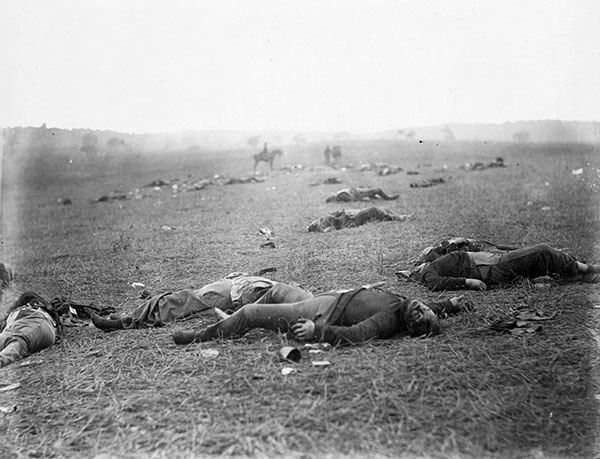
Above: Dead on the battlefield of Gettysburg, July 1863. More Irish Americans fell in the ranks of the regulars at Gettysburg than in the Irish Brigade. One of the most famous images of the war, this picture was taken by Irishman Timothy O’Sullivan. (Library of Congress)
Damian Shiels is a researcher at Northumbria University and runs the www.irishamericancivilwar.com website.
FURTHER READING
D. Gleeson, The green and the gray: the Irish in the Confederate States of America (Chapel Hill, 2013).
R. Keating, Shades of green: Irish regiments, American soldiers, and local communities in the Civil War era (Fordham, 2017).
D. Shiels, The Irish in the American Civil War (Dublin, 2013).
S. Ural, The harp and the eagle: Irish-American volunteers and the Union Army, 1861–1865 (New York, 2006).
















